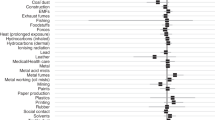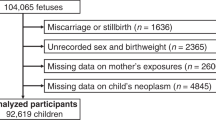Abstract
Little is known about the etiology of hepatoblastoma. We aimed to confirm the results of a previous study evaluating the association between parental occupational exposures and hepatoblastoma. In our case–control study, we identified cases (n=383) from the Children’s Oncology Group and controls from birth certificates (n=387), which were frequency matched to cases on year and region of birth, sex, and birth weight. Occupational exposure in the year before and during the index pregnancy was collected through maternal interview and analyzed using unconditional logistic regression. The odds of both paternal and maternal “Likely” exposure to paints was elevated among cases compared with controls (paternal odds ratio (OR): 1.71, 95% confidence interval (CI): 1.04, 2.81; maternal OR: 3.29, 95% CI: 0.32, 33.78) after adjustment for matching factors and the confounding factors of maternal race (maternal only) and household income. In addition, paternal exposure to other chemicals was also elevated when adjusting for matching factors only (OR: 1.53, 95% CI: 1.02, 2.30). The results of our study provide further evidence of an association between parental occupation and hepatoblastoma. These results warrant further investigation of the etiologically relevant timing of occupational exposure to fumes and chemicals related to hepatoblastoma.
This is a preview of subscription content, access via your institution
Access options
Subscribe to this journal
Receive 6 print issues and online access
$259.00 per year
only $43.17 per issue
Buy this article
- Purchase on Springer Link
- Instant access to full article PDF
Prices may be subject to local taxes which are calculated during checkout
Similar content being viewed by others
References
Howlader N, Noone AM, Krapcho M, Miller D, Bishop K, Altekruse SF et al. SEER Cancer Statistics Review, 1975-2013. National Cancer Institute: Bethesda, MD, USA. 2016.
Horner MJ, Ries LAG, Krapcho M, Neyman N, Aminou R, Howlader N et al. SEER Cancer Statistics Review, 1975-2006. National Cancer Institute: Bethesda, MD, USA. 2009.
Bulterys M, Goodman MT, Smith MA, Buckley J . Hepatic tumors. In: Ries LAG, Smith MA, Gurney JG, Linet M, Tamra T, Young JL (eds). Cancer Incidence and Survival among Children and Adolescents: United States SEER Program 1975-1995. National Cancer Institute, SEER Program: Bethesda, MD, USA. 1999.
Spector LG, Birch J . The epidemiology of hepatoblastoma. Pediatr Blood Cancer 2012; 59: 776–779.
Buckley JD, Sather H, Ruccione K, Rogers PC, Haas JE, Henderson BE et al. A case-control study of risk factors for hepatoblastoma. A report from the Childrens Cancer Study Group. Cancer 1989; 64: 1169–1176.
Turcotte LM, Georgieff MK, Ross JA, Feusner JH, Tomlinson GE, Malogolowkin MH et al. Neonatal medical exposures and characteristics of low birth weight hepatoblastoma cases: a report from the Children's Oncology Group. Pediatr Blood Cancer 2014; 61: 2018–2023.
Musselman JR, Georgieff MK, Ross JA, Tomlinson GE, Feusner J, Krailo M et al. Maternal pregnancy events and exposures and risk of hepatoblastoma: a Children's Oncology Group (COG) study. Cancer Epidemiol 2013; 37: 318–320.
Puumala SE, Ross JA, Feusner JH, Tomlinson GE, Malogolowkin MH, Krailo MD et al. Parental infertility, infertility treatment and hepatoblastoma: a report from the Children's Oncology Group. Hum Reprod 2012; 27: 1649–1656.
Ramachandran G . Occupational Exposure Assessment for Air Contaminants. CRC Press: Boca Raton, FL, USA. 2005.
Jahn S, Bullock WH, Ignacio J . A Strategy for Assessing and Managing Occupational Exposures, 4th edn. American Industrial Hygiene Association: Fairfax, VA, USA. 2015.
Greenland S, Pearl J, Robins JM . Causal diagrams for epidemiologic research. Epidemiology 1999; 10: 37–48.
Kleinbaum DG, Kupper LL, Nizam A, Muller KE . Applied Regression Analysis and Other Multivariable Methods, 4th edn. Thomson Brooks/Cole: Belmont, CA, 2008.
Sung TI, Wang JD, Chen PC . Increased risk of cancer in the offspring of female electronics workers. Reprod Toxicol 2008; 25: 115–119.
Pearce MS, Hammal DM, Dorak MT, McNally RJ, Parker L . Paternal occupational exposure to electro-magnetic fields as a risk factor for cancer in children and young adults: a case-control study from the North of England. Pediatr Blood Cancer 2007; 49: 280–286.
McKinney PA, Fear NT, Stockton D, Investigators UKCCS. Parental occupation at periconception: findings from the United Kingdom Childhood Cancer Study. Occup Environ Med 2003; 60: 901–909.
Mutanen P, Hemminki K . Childhood cancer and parental occupation in the Swedish Family-Cancer Database. J Occup Environ Med 2001; 43: 952–958.
Schuz J, Kaletsch U, Meinert R, Kaatsch P, Michaelis J . Risk of childhood leukemia and parental self-reported occupational exposure to chemicals, dusts, and fumes: results from pooled analyses of German population-based case-control studies. Cancer Epidemiol Biomarkers Prev 2000; 9: 835–838.
Heacock H, Hertzman C, Demers PA, Gallagher R, Hogg RS, Teschke K et al. Childhood cancer in the offspring of male sawmill workers occupationally exposed to chlorophenate fungicides. Environ Health Perspect 2000; 108: 499–503.
Smulevich VB, Solionova LG, Belyakova SV . Parental occupation and other factors and cancer risk in children: II. Occupational factors. Int J Cancer 1999; 83: 718–722.
Shu XO, Stewart P, Wen WQ, Han D, Potter JD, Buckley JD et al. Parental occupational exposure to hydrocarbons and risk of acute lymphocytic leukemia in offspring. Cancer Epidemiol Biomarkers Prev 1999; 8: 783–791.
Colt JS, Blair A . Parental occupational exposures and risk of childhood cancer. Environ Health Perspect 1998; 106: 909–925.
Rapisarda V, Loreto C, Malaguarnera M, Ardiri A, Proiti M, Rigano G et al. Hepatocellular carcinoma and the risk of occupational exposure. World J Hepatol 2016; 8: 573–590.
International Agency for Research on Cancer Chemical Agents and Related Occupations. IARC: Lyon, France. 2012.
Schuz J, Spector LG, Ross JA . Bias in studies of parental self-reported occupational exposure and childhood cancer. Am J Epidemiol 2003; 158: 710–716.
Lopez-Terrada D, Alaggio R, de Davila MT, Czauderna P, Hiyama E, Katzenstein H et al. Towards an international pediatric liver tumor consensus classification: proceedings of the Los Angeles COG liver tumors symposium. Mod Pathol 2014; 27: 472–491.
Greenland S . Multiple comparisons and association selection in general epidemiology. Int J Epidemiol 2008; 37: 430–434.
Rothman KJ . No adjustments are needed for multiple comparisons. Epidemiology 1990; 1: 43–46.
Spector LG, Ross JA, Puumala SE, Roesler M, Olshan AF, Bunin GR . Feasibility of nationwide birth registry control selection in the United States. Am J Epidemiol 2007; 166: 852–856.
Acknowledgements
Funding for this study (COG Study ID AEPI04C1) was provided through NIH Grant Number R01 CA111355, NCTN Operations Center Grant U10CA180886, NCTN Statistics & Data Center Grant U10CA180899, Chair's Grant U10CA098543, and Statistics and Data Center Grant U10CA098413.
Author information
Authors and Affiliations
Corresponding author
Ethics declarations
Competing interests
The authors declare no conflict of interest.
Additional information
Supplementary Information accompanies the paper on the Journal of Exposure Science and Environmental Epidemiology website
Supplementary information
Rights and permissions
About this article
Cite this article
Janitz, A., Ramachandran, G., Tomlinson, G. et al. Maternal and paternal occupational exposures and hepatoblastoma: results from the HOPE study through the Children’s Oncology Group. J Expo Sci Environ Epidemiol 27, 359–364 (2017). https://doi.org/10.1038/jes.2017.1
Received:
Accepted:
Published:
Issue Date:
DOI: https://doi.org/10.1038/jes.2017.1
Keywords
This article is cited by
-
miR-139-3p/Wnt5A Axis Inhibits Metastasis in Hepatoblastoma
Molecular Biotechnology (2023)
-
Environmental Risk Factors for Liver Cancer and Nonalcoholic Fatty Liver Disease
Current Epidemiology Reports (2019)



